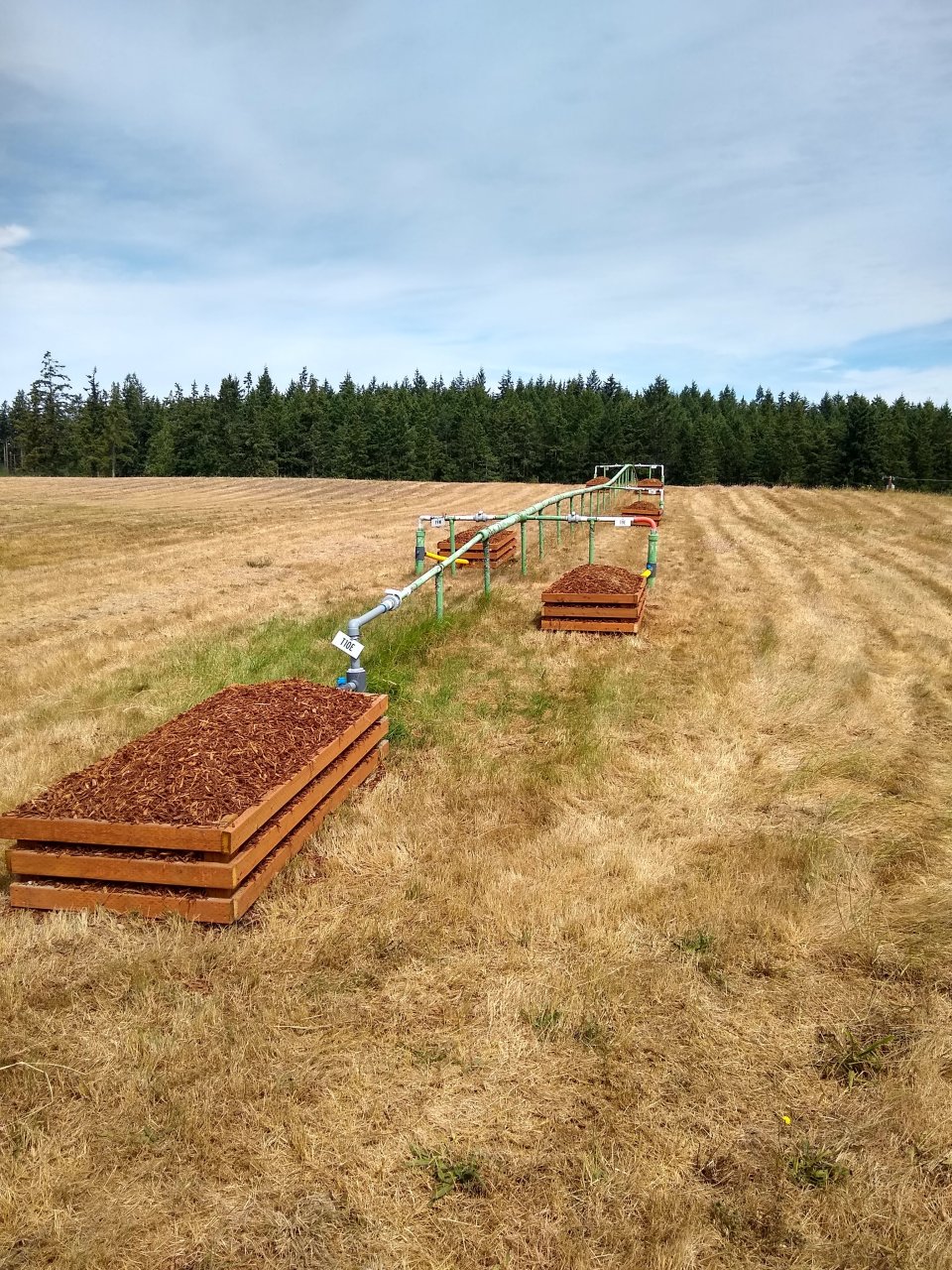Apply Biofilters or Biocovers
Biofilters and biocovers are passive methods of mitigating landfill gas (LFG) emissions.
A biofilter consists of a porous material layer as well as an organic material (often compost) layer to oxidize methane in LFG. A flexible tube or similar conveyance connects the gas vent to the biofilter to route the LFG. The biofilter may be enclosed in a container and may have a cover to prevent precipitation from entering the filter. Biofilters may be installed on a landfill without an active gas collection system (GCS) and could also be installed in areas of a landfill that are no longer connected to an active GCS.
A biocover is a porous material layer laid directly on top of a landfill which is then covered by an oxidizing layer of mature compost. Fugitive LFG filters through the cover and is oxidized. Biocovers may be used as a stand-alone technology or in combination with an active GCS.
Greenhouse Gas Mitigation Potential:
- Methane routed through a biofilter can be oxidized at a rate of up to 19 percent.1, 2 The oxidation rate depends heavily on biofilter design but also other factors such as air temperature.
- In addition to gas routed directly through a biofilter, some methane may be oxidized depending on cover type. For landfills without an active gas collection system, methane oxidation rates range from 10 percent in areas without final cover to 35 percent in areas with final cover.3
- A well-made biocover employing a large volume of aged compost can oxidize up to 35 or 40 percent of the methane in the gas passing through it.4 The oxidation rate is not constant and depends on the physical and biological characteristics of the filter material such as moisture, density and organic content as well as environmental factors such as air temperature.5, 6
Criteria:
Biofilters:
- Landfill (or area of a landfill) has declining gas flow or has passive vents and declining gas quality.
- Gas wells are not producing significant methane and are not under vacuum to an active GCS.
Biocovers:
- Applicable to all landfills including uncontrolled and older landfills with a passive or active GCS.
Pros:
- LFG can likely be passively routed to a biofilter or biocover. For biofilters, if pressure is not adequate a small blower could be installed to help the gas flow through the filter.
- Oxidation can also reduce other pollutants such as hydrogen sulfide.
- Because oxidation is a passive control, it has no secondary air pollutant emissions and its ongoing monitoring and maintenance costs are relatively low.
Cons:
- Methane oxidation rates are variable (factors affecting oxidation include temperature, moisture, and biofilter and biocover designs).
- These technologies have limited commercial applications.
Economic Considerations:
- Costs vary depending on local availability of materials – if local compost is available it would reduce costs and associated transportation emissions.
- Other costs would include installation of biofilters or biocovers and ongoing maintenance costs, e.g., watering the oxidizing materials in dry climates and measuring technology effectiveness over time.
- Typical biocover capital cost is $48,000 per acre.1
More Information:
- Available and Emerging Technologies for Reducing Greenhouse Gas Emissions from Municipal Solid Waste Landfills, EPA Office of Air Quality Planning and Standards
- Technologies and Management Options for Reducing Greenhouse Gas Emissions from Landfills, California Department of Resources Recycling and Recovery (CalRecycle)
- Biocovers at Landfills for Methane Emissions Reduction Demonstration, CalRecycle
- Biocovers of landfills, Climate Technology Centre & Network
- Webinar: Landfill Gas Electricity Power Purchase Agreement Ending Soon? Learn What You Can Do, EPA LMOP
References
1 U.S. EPA. Available and Emerging Technologies for Reducing Greenhouse Gas Emissions from Municipal Solid Waste Landfills. June 2011. https://www.epa.gov/sites/default/files/2015-12/documents/landfills.pdf.
2 Abichou, Tarek, et al. Mitigating methane emissions from passive landfill vents: a viable option for older closed landfills. January 2011. https://www.researchgate.net/publication/259006793_Mitigating_methane_emissions_from_passive_landfill_vents_a_viable_option_for_older_closed_landfills.
3 U.S. EPA. Documentation For Greenhouse Gas Emission and Energy Factors Used in the Waste Reduction Model (WARM). Management Practices Chapters. November 2020. https://www.epa.gov/sites/default/files/2020-12/documents/warm_management_practices_v15_10-29-2020.pdf.
4 CalRecycle (formerly the California Integrated Waste Management Board). Technologies and Management Options for Reducing Greenhouse Gas Emissions from Landfills. April 2008. https://www.ccacoalition.org/resources/technologies-and-management-options-reducing-greenhouse-gas-emissions-landfills.
5 Abichou, Tarek. Florida State University. FAMU-FSU College of Engineering. Our Experience with Methane Emissions and Methane Oxidation in Landfill Applications. Presented to Air and Waste Management Association. March 30, 2021.
6 CalRecycle. Biocovers at Landfills for Methane Emissions Reduction Demonstration. October 2010. https://www.yolocounty.org/home/showpublisheddocument/31494/635787934907730000.
7 MSW Management. Getting a Good Night’s Sleep. February 10, 2021. https://www.mswmanagement.com/landfills/waste-to-energy-landfill-gas/article/21163069/getting-a-good-nights-sleep.
8 Cairns, Al. Jefferson County Department of Public Works. Email correspondence. October 14, 2021.

